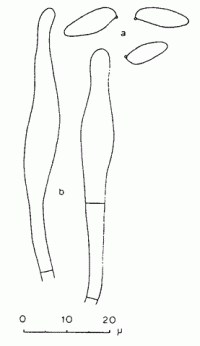|
 Xerocomus rufostipitatus Xerocomus rufostipitatus
BiostatusPresent in region - Indigenous. Endemic
Images (click to enlarge)
Caption: Fig. 2 - a, b, Xerocomus rufostipitatus: a, spores; b, cystidia. |
Article: McNabb, R.F.R. (1968). The Boletaceae of New Zealand. New Zealand Journal of Botany 6(2): 137-176 (http://www.rsnz.org/publish/abstracts.php).
Description: PILEUS: plano-convex, 2.5 cm diam., dry, velutinate, cocoa brown to chocolate
brown; cuticle a trichodermium, composed of erect, branched, septate hyphae
4.5-7 µm. diam., terminal cells typically with acuminate to mucronate apices
and brownish contents; margin entire. HYMENOPHORE: tubes to 6 mm long, deeply
excavated around apex of stipe, greenish yellow; pores dark red, small, angular,
0.25-0.5 mm diam. STIPE: 3 cm long, more or less equal, 8 mm diam., solid, fibrous,
dry, finely granular to furfuraceous by aggregation of caulocystidia, red to
dark red; annulus absent.
SPORES: spore print not obtained;
spores pallid melleous, elliptic-subfusiform, 9.8-12.6-(13.6) X 3.5-4.9 µm,
smooth. HYMENIUM: basidia hyaline, clavate, 28-39 x 7.5-11.5 µm, 4-spored; cystidia
scattered, hyaline thin-walled, subcylindrical to narrowly ventricose-rostrate,
occasionally 1-septate, 38-58 X 7-9 µm. HYMENOPHORAL TRAMA: bilateral, of the
Phylloporus subtype; clamp connections absent. CONTEXT OF PILEUS: cream,
unchanging on exposure to air. SMELL: not distinctive.
Habitat: HABITAT: Solitary under Nothofagus.
Notes: Xerocomus rufostipitatus cannot be placed in one of the sections recognised
by Singer (1962) as the ammonia reaction of fresh pilei is not known.
The species may be recognised by the velutinate, cocoa brown
to chocolate brown pileus, dark red pores and stipe, and small fruitbodies.
X. mcrobbii also possesses dark red pores and a reddish stipe, but differs
in the coarsely fibrillose-scaly pileus, yellow base to the stipe, and broader
spores.
|